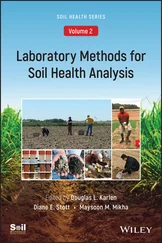Soil Health Analysis, Set
Здесь есть возможность читать онлайн «Soil Health Analysis, Set» — ознакомительный отрывок электронной книги совершенно бесплатно, а после прочтения отрывка купить полную версию. В некоторых случаях можно слушать аудио, скачать через торрент в формате fb2 и присутствует краткое содержание. Жанр: unrecognised, на английском языке. Описание произведения, (предисловие) а так же отзывы посетителей доступны на портале библиотеки ЛибКат.
- Название:Soil Health Analysis, Set
- Автор:
- Жанр:
- Год:неизвестен
- ISBN:нет данных
- Рейтинг книги:3 / 5. Голосов: 1
-
Избранное:Добавить в избранное
- Отзывы:
-
Ваша оценка:
- 60
- 1
- 2
- 3
- 4
- 5
Soil Health Analysis, Set: краткое содержание, описание и аннотация
Предлагаем к чтению аннотацию, описание, краткое содержание или предисловие (зависит от того, что написал сам автор книги «Soil Health Analysis, Set»). Если вы не нашли необходимую информацию о книге — напишите в комментариях, мы постараемся отыскать её.
Soil Health Analysis, Set — читать онлайн ознакомительный отрывок
Ниже представлен текст книги, разбитый по страницам. Система сохранения места последней прочитанной страницы, позволяет с удобством читать онлайн бесплатно книгу «Soil Health Analysis, Set», без необходимости каждый раз заново искать на чём Вы остановились. Поставьте закладку, и сможете в любой момент перейти на страницу, на которой закончили чтение.
Интервал:
Закладка:
Soil quality activities around the world expanded rapidly during the early 1990s, driven in part by increasing recognition of the role soils had in buffering and mitigating factors affecting environmental quality (Warkentin, 1992). However, the true global driver and inspiration for the advancement of soil health or quality was Dr. John W. Doran, to whom this book series is dedicated. His perspective stating that “soil health, or quality, can be broadly defined as the capacity of a living soil to function, within natural or managed ecosystem boundaries, to sustain plant and animal productivity, maintain or enhance water and air quality, and promote plant and animal health” (Doran, 2002) is to us, the ultimate goal for soil health. He also emphasized that soil health will change over time due to natural events or human impacts.
In Australia, Powell and Pratley (1991) developed a “Sustainability Kit” that provided guidelines for measuring soil structure, acidity (pH), salinity, and soil/water temperature. This kit also served as a precursor to John Doran’s field‐based soil health kit developed in collaboration with scientists at the Rodale Research Center and tested throughout the country (Liebig et al., 1996). Marketed with a USDA Soil Management Manual, the “Soil Health Kit” described simplified tests for soil respiration (Liebig 1996; Doran 1997), infiltration (Ogden et al., 1997), bulk density (Doran 1984), electrical conductivity (EC), pH, and nitrate‐nitrogen (NO 3‐N) concentrations (Smith and Doran, 1996); a soil structure index and penetration test (Bradford and Grossman 1982); soil slaking and aggregate stability tests (Herrick et al. 2001); and an earthworm assessment protocol (Linden 1994). Since that time, the power and potential for on‐farm testing of soil health indicators has been greatly magnified by development of the internet, smartphones, and applications such as the Land‐Potential Knowledge System (LandPKS; Herrick et al., 2013).
Other developments included a symposium sponsored by the North Central Region Committee No. 59 that focused on SOM at the Soil Science Society of America (SSSA) meetings. That event led to the SSSA publishing two books that became known as the “blue” (Doran et al., 1994) and “green” (Doran and Jones, 1996) soil quality guides that are the precursors for this two‐volume series. Doran (2002) also provided important insight stating that although soils have an inherent quality associated with their physical, chemical, and biological properties, their sensitivity to climate and management practices means that land manager decisions ultimately determine soil health. He continued stating a pivotal role for scientists is translating scientific information regarding soil functions into practical tools that land managers can use to evaluate the sustainability of their management practices. Soil health indicators thus became the tools for making the assessments, but there is no single indicator or technology that will always be appropriate.
Soil health assessment has also been advanced by the NRCS, through databases at the Kellogg Soil Survey Laboratory (KSSL), National Soil Survey Center in Lincoln, NE that currently have analytical data for more than 20,000 U.S. pedons and at least 1,100 more from other countries (Brevik et al., 2017). Collectively, morphological descriptions are available for about 15,000 pedons ( https://www.nrcs.usda.gov/wps/portal/nrcs/detail/soils/research/?cid=nrcs142p2_053543#:~:text=Summary,1%2C100%20pedons%20from%20other%20countries) (verified 6‐12‐2020).
The NRCS also has extensive data on basic soil properties, landscape characteristics, and interpretations for use and management. Those databases, describing inherent soil properties, provide a resource to match various land uses with inherent ability of individual soils to perform critical functions (Karlen et al., 2003a). Building upon those resources, the NRCS created several cross‐cutting teams during the 1990s, including the Soil Quality Institute (SQI) whose scientists developed many of the first‐generation soil quality/soil health scorecards, assessment tools, and information packets. The SQI compiled soil quality information for NRCS staff to help them integrate soil quality concepts into conservation planning and resource inventory activities for their stakeholders (SQI, 1996). The SQI also provided leadership and collaboration for research studies designed to evaluate soil quality indicators at several scales, including Natural Resources Inventory (NRI) sites within four Major Land Resource Areas (Brejda et al., 2000a, 2000b, 2000c).
Linkages between soil and environmental quality were significantly strengthened by the National Academy of Sciences Soil and Water Quality: An Agenda for Agriculture publication (NRC, 1993). It prompted Dr. L.P. Wilding, 1994 president of the SSSA, to appoint a 14‐person committee (S‐581) with representatives from all SSSA Divisions. Appointees were asked to define the concept of soil quality, examine its rationale, determine if pursuing its development should be a core SSSA activity, and identify soil and plant attributes that would be useful for describing and evaluating soil quality (Karlen et al., 1997).
One of the first comprehensive soil quality/health assessments was used to quantify benefits of the CRP. Following passage of the 1985 Food Security Act, that program took 14.7 million hectares (36.4 million acres) in 36 states out of production (Skold, 1989). Recognized as environmentally sensitive or highly erodible land (HEL), the primary goal was to reduce soil erosion. Secondary CRP goals included: protecting the nation's ability to produce food and fiber, improving air and water quality, carbon sequestration, reducing sedimentation, fostering wildlife habitat, curbing production of surplus commodities, and providing income support for farmers (Allen and Vandever, 2012; FAPRI, 2007; Follett et al., 2001; Li et al., 2017). In exchange for retiring HEL for 10 years, USDA paid CRP participants (farm owners or operators) an annual per‐acre rent and half of the cost of establishing a permanent land cover (Young and Osborn, 1990).
Soil quality assessment thus emerged as an evaluation tool as many first‐round contracts began to expire (Karlen et al., 1998). Since then, a plethora of studies have evaluated the CRP effect on soil health (Baer et al., 2002; Knops and Tillman, 2000; Matamala et al., 2008; Mensah et al., 2003; Reeder et al., 1998; Rosenzweig et al., 2016; De et al., 2020). Most have focused on insensitive or slower changing soil health indicators (e.g., soil organic carbon [SOC] and N pools). Only a few have evaluated more management‐sensitive active carbon pools, such as potentially mineralizable carbon (PMC), potentially mineralizable nitrogen (PMN) microbial biomass carbon (MBC) and soil microbial communities (Baer et al., 2002; Matamala et al., 2008; Haney et al., 2015; Rosenzweig et al., 2016; Li et al., 2018; De et al., 2020).
In Canada, the concept of soil quality/soil health was revived nearly a decade after its introduction by Warkentin and Fletcher (1977) when the Canadian Senate Standing Committee on Agriculture prepared a report on soil degradation (Gregorich, 1996). The research branch of Agriculture and Agri‐Food Canada began to work with federal and provincial governments, universities, and the private sector to develop a Soil Quality Evaluation Program (Acton and Gregorich, 1995). Collectiveluy they sought to identify sensitive and reliable indicators (Larson and Pierce, 1991; Haberern 1992; Doran et al., 1994; Doran and Parkin, 1994; Karlen et al., 1994a, 1994b; Karlen et al., 1996). Soil quality assessment began to be interpreted as a sensitive and dynamic way to document soil conditions, response to management, or resistance to the stress imposed by natural forces or human uses (Arshad and Coen, 1992; Haberern, 1992). Their efforts focused on indicator development since soil quality/soil health per se cannot be measured directly. This resulted in efforts to identify a minimum set of biological, chemical, and physical measurements (Doran and Parkin, 1996) that provided useful and meaningful information regarding how a specific soil was functioning in response to a specific use and/or management practice (e.g., tillage system, crop rotation, stover harvest, irrigation management, or land‐use changes).
Читать дальшеИнтервал:
Закладка:
Похожие книги на «Soil Health Analysis, Set»
Представляем Вашему вниманию похожие книги на «Soil Health Analysis, Set» списком для выбора. Мы отобрали схожую по названию и смыслу литературу в надежде предоставить читателям больше вариантов отыскать новые, интересные, ещё непрочитанные произведения.
Обсуждение, отзывы о книге «Soil Health Analysis, Set» и просто собственные мнения читателей. Оставьте ваши комментарии, напишите, что Вы думаете о произведении, его смысле или главных героях. Укажите что конкретно понравилось, а что нет, и почему Вы так считаете.












